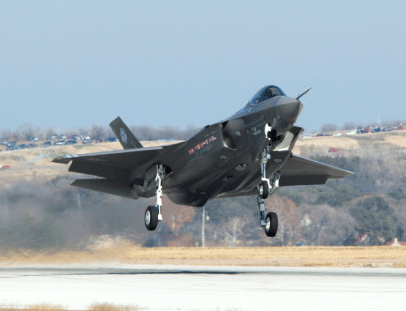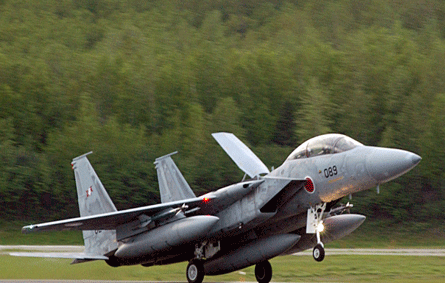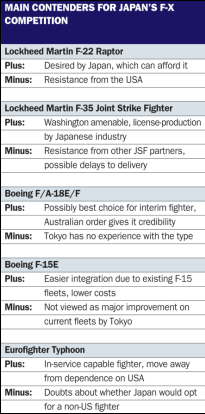Would it surprise anyone if the favourite song right now in Japan's Ministry of Defence is The Rolling Stones' You can't always get what you want?
For the last two years, Japan's politicians and civil servants have been intensely lobbying their counterparts in the USA to secure information on the Lockheed Martin F-22 Raptor for their country's upcoming F-X competition. Their efforts have only led them to a brick wall.
 |
|---|
©USAF/Snr Airman Garnett-HothamThe F-22 is top of Japan's wishlist, but the USA refuses to export it |
Being one of Washington's closest allies in East Asia is not enough to get access to data on the highly coveted fifth-generation aircraft. Neither is the fact that it is one of the few countries in the world that could afford the $200 million price tag, or that an order from Tokyo would reduce the unit cost of each aircraft for the USA and keep the production line open for Lockheed.
Congress's Obey Amendment prohibits the sale of the F-22 to any foreign government due to the level of technology incorporated into the fighter, and that is unlikely to change in the near term. In 2007, the US State Department said: "US law prohibits the US from selling the F-22. The United States is committed to working with Japan as Japan chooses its future fighter aircraft, to find the appropriate capabilities for a strong and credible alliance."
Japan has been indefinitely delaying the start of its F-X competition while it continues to lobby the USA. However, it desperately needs at least 50 aircraft to replace its ageing McDonnell Douglas F-4s and prevent a decline in its air capability. If it does not make a move soon, the decision could be catastrophic. Yet the impasse continues.
Tokyo has also sought information on the Lockheed F-35 Joint Strike Fighter, Boeing's F/A-18E/F Super Hornet and F-15, France's Dassault Rafale and the Eurofighter Typhoon. Ostensibly, it will evaluate all the options equally. In reality, if the USA releases the F-22, that is what it will buy. "You must understand their thinking. The Japanese want the best fighter and that, in their mind, is the F-22. It does not matter if the F-22 is actually suitable for Japan, and there is a separate debate about that issue," says a Tokyo-based observer.
 |
|---|
©Lockheed MartinThe F-35 would be Japan's second choice, but the country has not joined the programme |
Given that the sale of fighters is a foreign policy tool for the USA, the Japanese view the refusal as a major snub. "The Americans say Japan is an important partner and want it to take on additional responsibility for regional security. Yet the Japanese feel that they are not given the tools to do the job. That irks them, especially as they feel that they have been good friends and allies," adds a second observer.
Some point out that the F-22, which is superior to almost any fighter in service, may be exactly what Japan needs as a deterrent against a rapidly modernising Chinese air force and the threat of a missile attack from an unstable North Korea.
"It's so capable that policymakers aren't inclined to export it, even to trusted allies like Japan," Loren Thompson, an analyst with the US-based Lexington Institute, points out in a research paper.
"But does that really make sense if Raptor is the aircraft best suited to protecting the Japanese home islands against cruise missile attack or pre-empting a ballistic missile launch by North Korea?"
Lockheed appears to be keen on a sale as that would allow it to keep the production line open beyond 2011, when the US air force's last F-22 will roll out if there are no further orders.
"The company has over 3,000 employees working on the Raptor, and many more are employed by subcontractors like Pratt & Whitney and Boeing. This is crucial for the American aerospace industry," says a source close to the company.
Another source adds: "Exporting the F-22 would help Lockheed to lower the cost of each aircraft, including those for the USA, and keep the price even lower if there are further orders from the Pentagon."
An option is to develop an export version of the F-22 for Japan, reducing its capabilities and putting in place measures to prevent unauthorised leaks of technology.
But this would take years to develop and cost several billion dollars, making it "prohibitively expensive" for any would-be foreign buyer, says Lt Gen Jeffrey Kohler, head of the Pentagon's Defense Security Cooperation Agency, responsible for government-to-government arms sales. "This aircraft was built to give us an edge way into the future, and that's why it's not exportable," he adds.
ELECTIONS
So where does that leave Japan? It will wait until after the US presidential and congressional elections in November, and perhaps until its own general elections, due before September next year. With a new administration and fresh mandates in both countries, it should be easier to move on, say observers.
If the F-22 is not available, the next likeliest option is the F-35, which the USA has indicated that it would be willing to sell. While not as advanced as the F-22, the JSF has stealth technology as well. There are also indications that Lockheed could allow Japanese industry to licence-produce the aircraft.
However, the other JSF partners may not agree to Japan, which has not joined the programme, jumping the queue and getting the fighter ahead of them around 2015. Even if they do agree, there are indications that the F-35 could be delayed and that would mean that Japan gets the fighter later than expected.
In that case, Tokyo could go for one of the other fighters on the table. The F/A-18E/F would be a strong contender, especially since Australia has ordered the aircraft as a stop-gap before the delivery of its F-35s.
Japan's airforce, however, already operates the F-15C-based F-15J and a newer version of the fighter would make the integration easier, especially if this is an interim order before the delivery of the F-35.
Many believe that US manufacturers will continue to monopolise the Japanese market, but others say that European fighters could stand a chance in the current climate.
In a report for the US Congress, Christopher Bolkcom and Emma Chanlett-Avery of the Congressional Research Service point out: "Purchasing European aircraftwould allow Japan to establish a second source of technology, and thus some autonomy from the United States, and European governments would be expected to offer very attractive terms to penetrate the heretofore closed Japanese market."
If it comes to that, the Typhoon is the likelier option and Eurofighter officials have been lobbying the Japanese over the last year. Alan Garwood, director of business development at BAE Systems, a partner in the Eurofighter programme, said at the Farnborough air show that Japan "likes the look" of the aircraft.
"The Typhoon is almost as capable the big difference is that the F-22 is stealthy," he added. Crucially, the consortium is willing to share more of its technology than the USA would with the F-22.
Others, however, believe that US and Japanese security interests are so intertwined that Tokyo is unlikely to buy anything but US military hardware. "Who would the Japanese work with if there was a conflict in the region? It is certainly not the Europeans. The Americans are their closest allies, and it makes little sense to buy aircraft that are unable to operate in tandem with the USAF," says an observer.
While it decides, the MoD is seeking funds to speed up its F-15 upgrade programme and extend the life of its F-4s to prevent a drop in Japan's air capability. It is also continuing the studies on the ATD-X programme to develop an indigenous stealth fighter.
 |
|---|
© USAF/ Tech Sgt Keith BrownOpting for a stop-gap buy of F15s would make sense for Japan as it already operates F-15Js |
However, as the observer points out, this is not what Japan wants. "The ATD-X programme is unlikely to move into the development stage as it would simply be too expensive and take too long. At the end of the day, Japan wants the F-22.
If Washington says no, it will move on to something else and that is likely to be another American fighter," he adds. "That decision, though, could have a permanent impact on bilateral relations. The talks about the F-22 over the next few months could also be a discussion about the future of the US-Japan security relationship."

Source: Flight International























